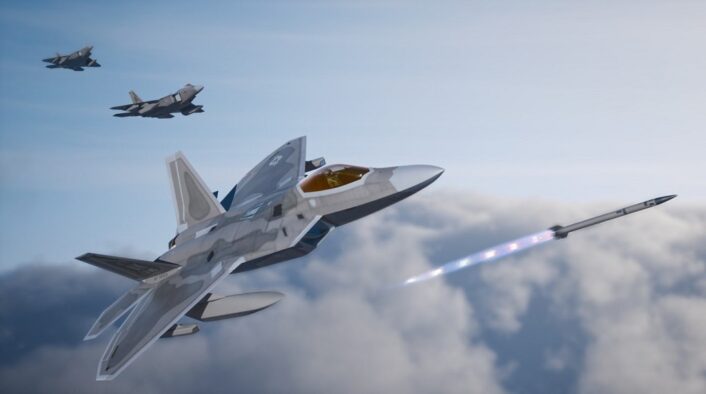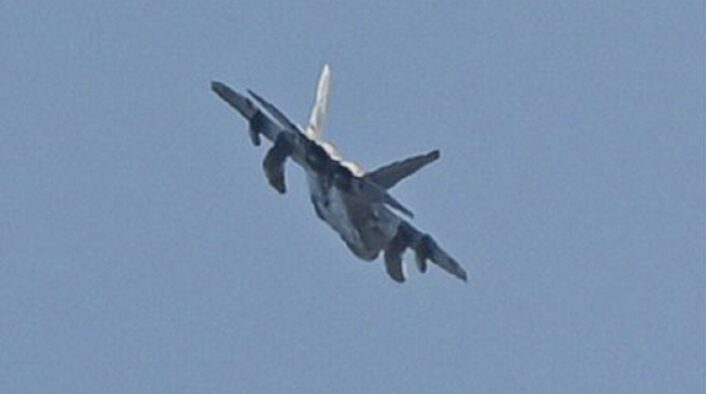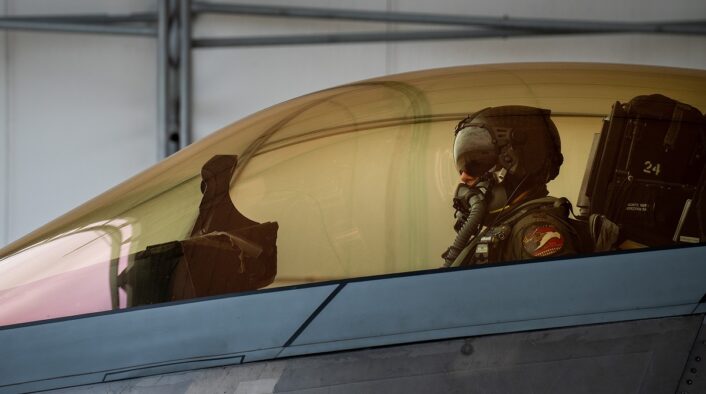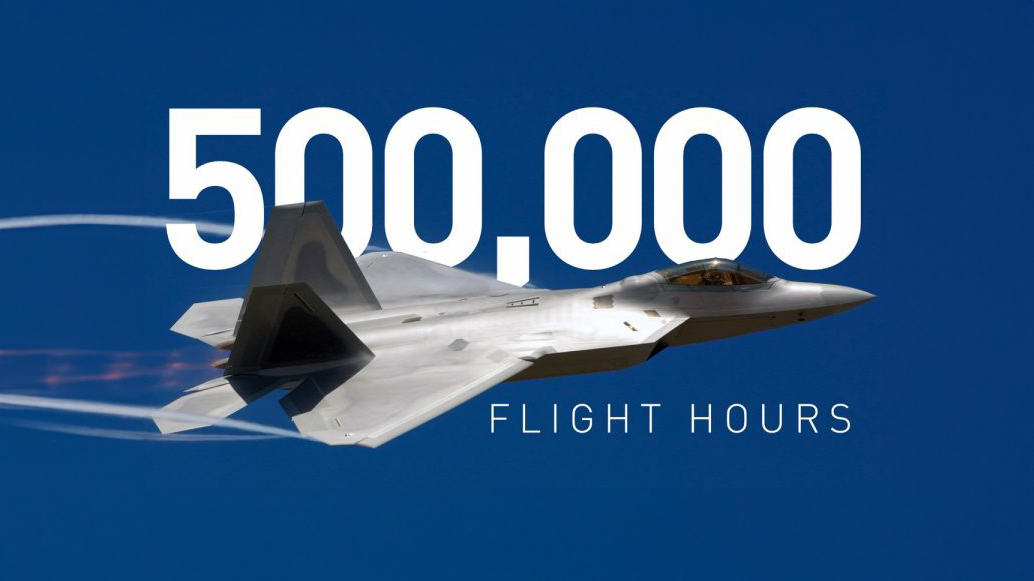The first 5th generation air superiority fighter of the U.S. Air Force has recently reached the important milestone, more than 25 years after its introduction in service.
Lockheed Martin has just announced that the F-22A Raptor fleet has recently reached the 500,000 flight hours milestone. More than 25 years after its introduction in service, the F-22 is still considered the most advanced air superiority fighter ever built and it’s being tooled up to keep that role for the years to come.
“As we celebrate 500,000 flight hours, we look ahead to the continued evolution of not only the F-22 but air combat in its entirety,” said Lockheed Martin. “The ongoing modernization efforts and strategic upgrades being made to the F-22 today will further enhance its capabilities, while also enabling the next generation of air dominance.”
The U.S. Air Force describes the Raptor as a combination of stealth, supercruise, maneuverability, and integrated avionics, designed to project air dominance, rapidly and at great distance. Initially introduced as an air-superiority-only asset, the F-22 later started performing both air-to-air and air-to-ground missions.
In the last few years, the service started seeking approval from the Congress to begin retiring the oldest airframes, freeing up resources for the remainder of the fleet. The decision was expected to cause the divestment of all but three Block 20 aircraft, reducing the overall F-22 fleet from 186 to 153 aircraft.
Among the reasons behind this plan, the service listed the high costs that would be required to upgrade these 33 aircraft to an operational status, currently used for training as the Block 20 has only basic air-to-ground capabilities, compared to more recent Blocks. The retirement plan was already blocked by the FY23 National Defense Authorization Act (NDAA), and the FY25 NDAA aims to continue on the same path.
The upgrades and the future of the F-22 Raptor
Some of the upgrades expected for the F-22 Raptor were unveiled in the Fiscal Year 23 budget request documentation and in an official artwork shared by Gen. Mark Kelly, then Commander of Air Combat Command. In the artwork we can see three Raptors loaded with new stealthy external fuel tanks, two underwing faceted pods and a new unknown air-to-air missile, but there are even more novelties in the documents, which unveils a previously undisclosed relationship between the F-22 and the development of the Next Generation Air Dominance (NGAD).
The two pods installed under the outer underwing hardpoints have already been spotted during flight testing on an F-22 at the Air Force’s Plant 42 facility in Palmdale, California, in February 2022. The latest budget documents mention an InfraRed Search and Track (IRST) sensor being developed for the F-22, which could be the sensor housed inside the two pods, although they could host also other capabilities in addition to the IRST.

The addition on the F-22 of an IRST system like the F-35’s Electro Optical Targeting System (EOTS) would require heavy and expensive modifications to the airframe, so a podded solution seems the most reasonable possibility. The addition of an internal IRST sensor on the Raptor was also considered not possible by Lockheed Martin some years ago.
The new stealthy external fuel tanks have been possibly spotted earlier this year during a flight test. In fact, back in March, an F-22 was captured near the Mojave Air and Space Port with two fuel tanks, whose shape is reminiscent of the one shown in 2022, and the two IRST pods.
The tanks are officially known as Low Drag Tank and Pylon (LDTP) and designed to be stealthier and more aerodynamically efficient than the current 600-gallon fuel tanks. In the FY2023 budget request, the Air Force mentioned that the F-22 LDTPs are advanced technological designs providing increased persistence and range while maintaining lethality and survivability, critical to future mission execution and to maintaining Air Superiority.
The low drag tanks are intended to reduce drag, facilitate supersonic flight with external tanks and extend the range of the F-22. The pylons are equipped with smart rack pneumatic technology to accurately control ejection performance and smooth wind swept surface for minimum drag without store.
The FY2025 budget re quest documents say that wind tunnel and ground testing of the new drop tanks was completed last year, with flight testing planned in early 2024. The documents also state that the full certification is planned for 2025 and delivery to operational squadrons is expected the next year.

The last upgrade featured in the artwork is a new unknown air-to-air missile. While there are a number of air-to-air missile programs in the works, it is possible that the one in the image could be a representative design, which may or may not correspond to the real deal, for the highly secretive AIM-260 missile. So far, the missile has never been depicted in any kind of image and details about the program are very scarce.
The development of the AIM-260, also called Joint Advanced Tactical Missile, was first unveiled in 2019 and has been in the works at least since 2017. The goal of the new long-range air-to-air missile is to replace the AIM-120 AMRAAM (Advanced Medium Range Air-to-Air Missile) and counter the threat posed by the Chinese PL-15 missile, while avoiding any foreign threats being able to outrange the AIM-120.
Among the few known technical details, the new missile will be compatible with the AMRAAM’s dimensions, but obviously with greater range, and is planned to be carried in the F-22 weapons bay and on the F/A-18 at first, with the F-35 to follow. Flight tests are already in progress and the missile is expected to be fielded by next year. Because of these reasons, it would be reasonable to suppose that the one shown in the image could be at least a hint at the AIM-260.
Other upgrades mentioned in the budget request are a Mode 5 Identification Friend or Foe (IFF), Link 16 and Multifunction Information Distribution System Joint Tactical Radio System (MIDS JTRS), a new Operational Fight Program, advanced radar Electronic Protection, Embedded GPS/Inertial Navigation System (INS) Modernization (EGI-M), Open System Architecture (OSA), new encrypted radios.
Last year, the Raptor was also involved in the tests of the Next Generation Fixed Wing Helmet (NGFWH), the Air Force’s new helmet design for fixed wing pilots. The NGFWH aims to provide pilots a more comfortable, stable, and balanced platform to accommodate helmet-mounted devices usage without imposing neck strain and discomfort to the user.

The testing, the second round of developmental tests with the LIFT-manufactured helmet since it was awarded the contract in 2022, involved approximately five F-22A Raptor pilots from the 301st Fighter Squadron at Eglin Air Force Base. Another round of testing will be performed once the Raptor complete their move from Eglin to Joint Base Langley-Eustis, Virginia.
The shape and size of the NGFWH allow for more mobility and visibility, as well as more comfort in the cockpit. It’s not clear whether the size of the new helmet has been reduced enough to allow the helmet-mounted cueing system to be compatible with the F-22 canopy.
Today, most of the combat aircraft (including today use a Helmet Mounted Display: with an HMD (like the JHMCS, the F-35’s HMD or the Eurofighter HMSS), information imagery (including aircraft’s airspeed, altitude, weapons status, aiming etc) are projected on the visor enabling the pilot to look out in any direction with all the required data always in his field of vision. For instance, the HMD enables the pilot to engage a target with a missile by simply looking at it.
Despite various integration efforts in the past, the F-22 is not equipped yet with a helmet that provides the essential flight and weapon aiming information through line of sight imagery: the shape of the Raptor’s canopy, optimized to preserve Low Observability, doesn’t allow enough range of motion and minimum visibility to a pilot wearing the JHMCS or the Scorpion HObIT.
While the Air Force seems focused on retiring the oldest Raptors, saying their upgrades would be too expensive, is working hard to upgrade the remaining ones to be equipped with cutting-edge capabilities and be relevant in any scenario they could fly into until they are replaced by the NGAD.













